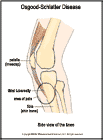
Osgood-Schlatter Disease
What is Osgood-Schlatter disease?
Osgood-Schlatter disease is a painful enlargement of the bump of the shin bone (tibia) just below the knee. This bump is called the tibial tuberosity. The tendon from the kneecap (patella) inserts here. Osgood-Schlatter disease is most often seen in children between the ages of 10 and 15 and usually appears during a period of rapid growth.
How does it occur?
Osgood-Schlatter disease is caused by overuse of the knee in normal childhood and sporting activities. It is possible that muscles are too tight in the front of the thigh, the back of the thigh, or in the calf.
What are the symptoms?
Your child will complain of a painful bump below the kneecap. The parents or child may notice a bony enlargement at the top of the shin bone. The pain will sometimes come and go and usually is gone by the time your child has stopped growing. Sometimes young adults can have pain in the area of the bump. Your child will always have a bump even after the pain has gone away.
How is it diagnosed?
Your child's health care provider will do a physical examination of the knee and review your child's symptoms. X-rays show an enlarged tibial tuberosity. An x-ray may also show irregular or loose bony fragments from the tibial tuberosity.
How is it treated?
Your child may need to rest or do activities that do not cause knee pain. Ice packs should be applied to the knee for 20 to 30 minutes every 3 to 4 hours for 2 to 3 days or until the pain goes away. If the knee is swollen, it should be elevated by placing a pillow under it. Your child's health care provider may prescribe a special padded brace. He or she may prescribe an anti-inflammatory medication and may recommend exercises.
When can my child return to his or her sport or activity?
The goal of rehabilitation is to return your child to his or her sport or activity as soon as is safely possible. If your child returns too soon the injury may worsen, which could lead to permanent damage. Everyone recovers from injury at a different rate. Return to his or her sport or activity will be determined by how soon your child's knee recovers, not by how many days or weeks it has been since the injury occurred. In general, the longer your child has symptoms before starting treatment, the longer it will take to get better.
Your child may safely return to his or her sport or activity when, starting from the top of the list and progressing to the end, each of the following is true:
- Your child's tibial tuberosity is no longer tender.
- The injured knee can be fully straightened and bent without pain.
- The knee and leg have regained normal strength compared to the uninjured knee and leg.
- Your child is able to jog straight ahead without limping.
- Your child is able to sprint straight ahead without limping.
- Your child is able to do 45-degree cuts.
- Your child is able to do 90-degree cuts.
- Your child is able to do 20-yard figure-of-eight runs.
- Your child is able to do 10-yard figure-of-eight runs.
- Your child is able to jump on both legs without pain and jump on the injured leg without pain.
How can Osgood-Schlatter disease be prevented?
Osgood-Schlatter disease may be difficult to prevent. The most important thing to do is to have your child limit activity as soon as he or she notices the painful bump on the top of the shin bone. Proper warm-up and stretching exercises of the thigh, hamstring, and calf muscles may help prevent Osgood-Schlatter disease.

